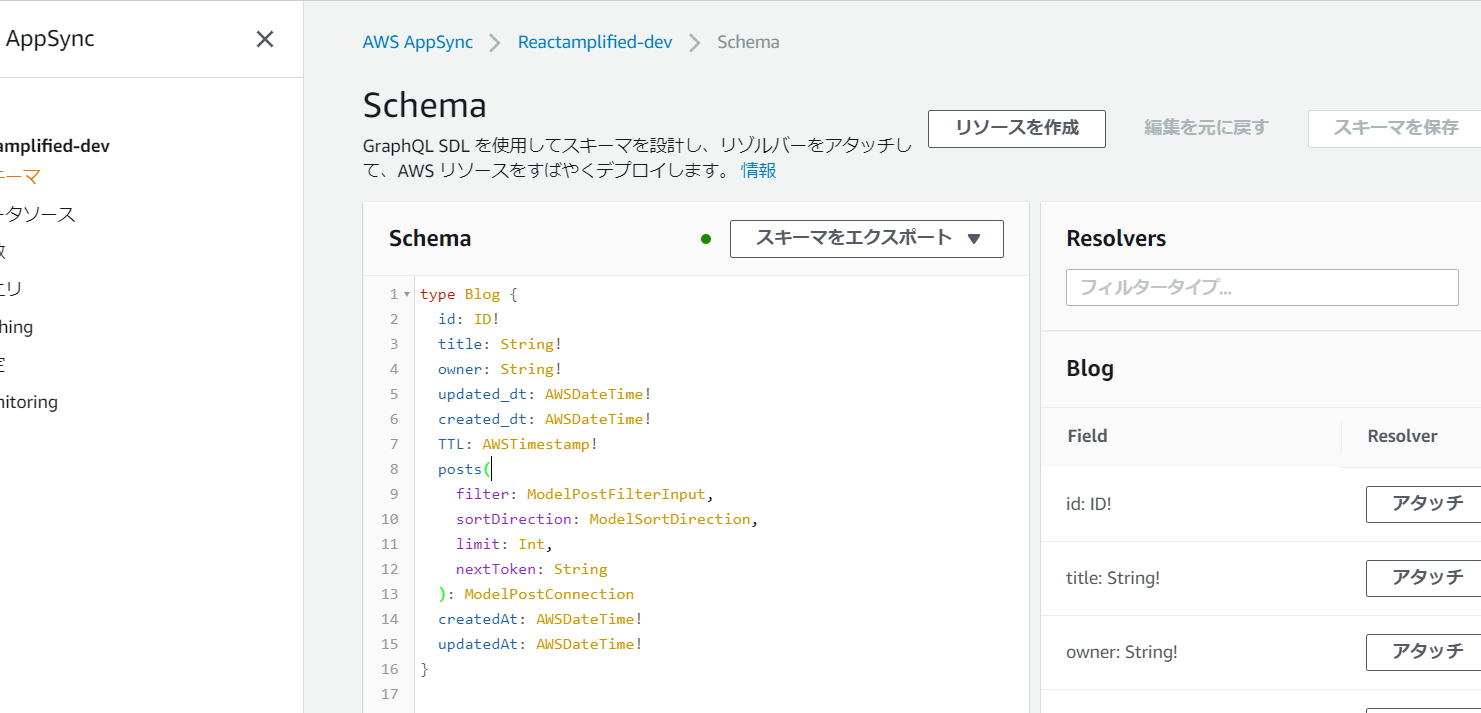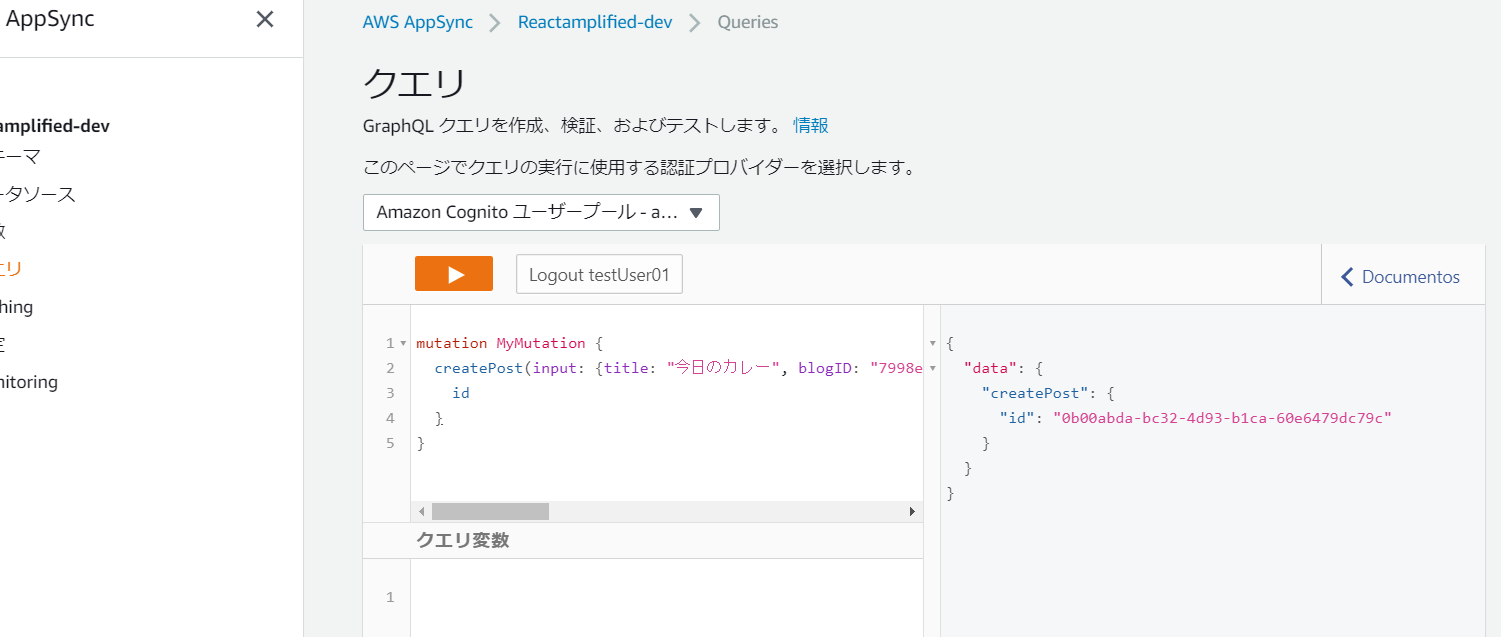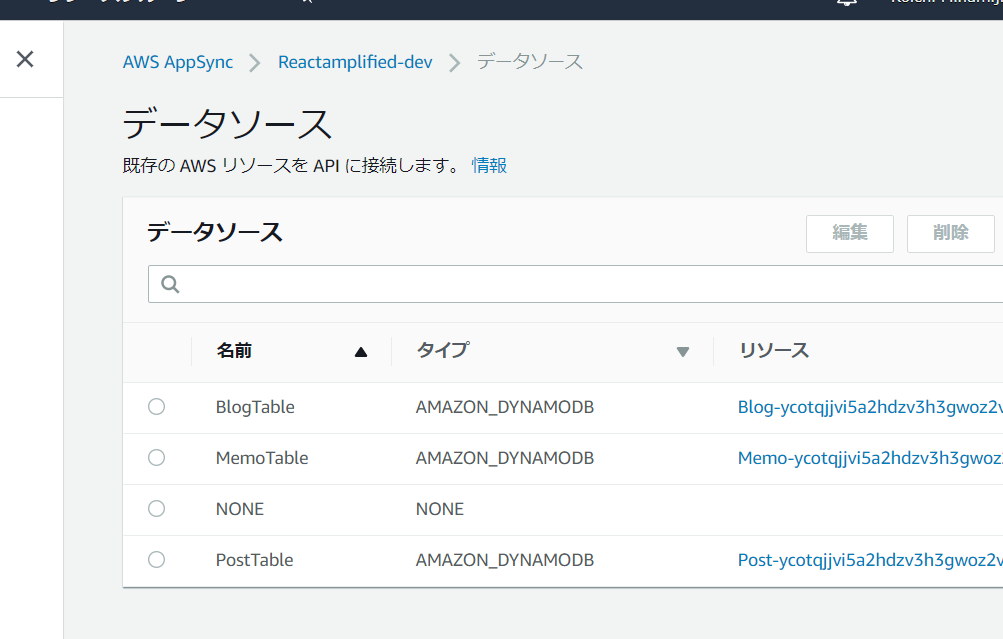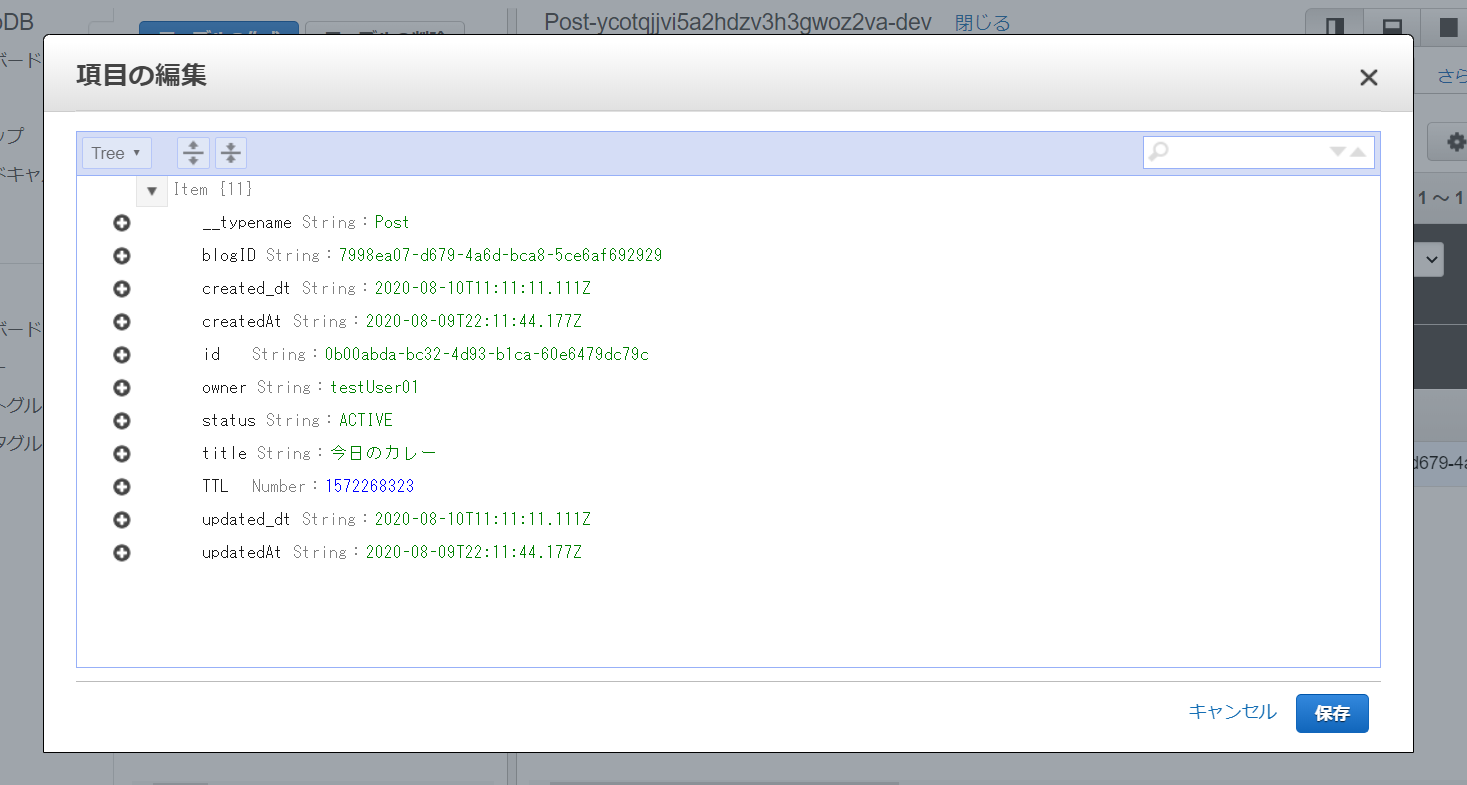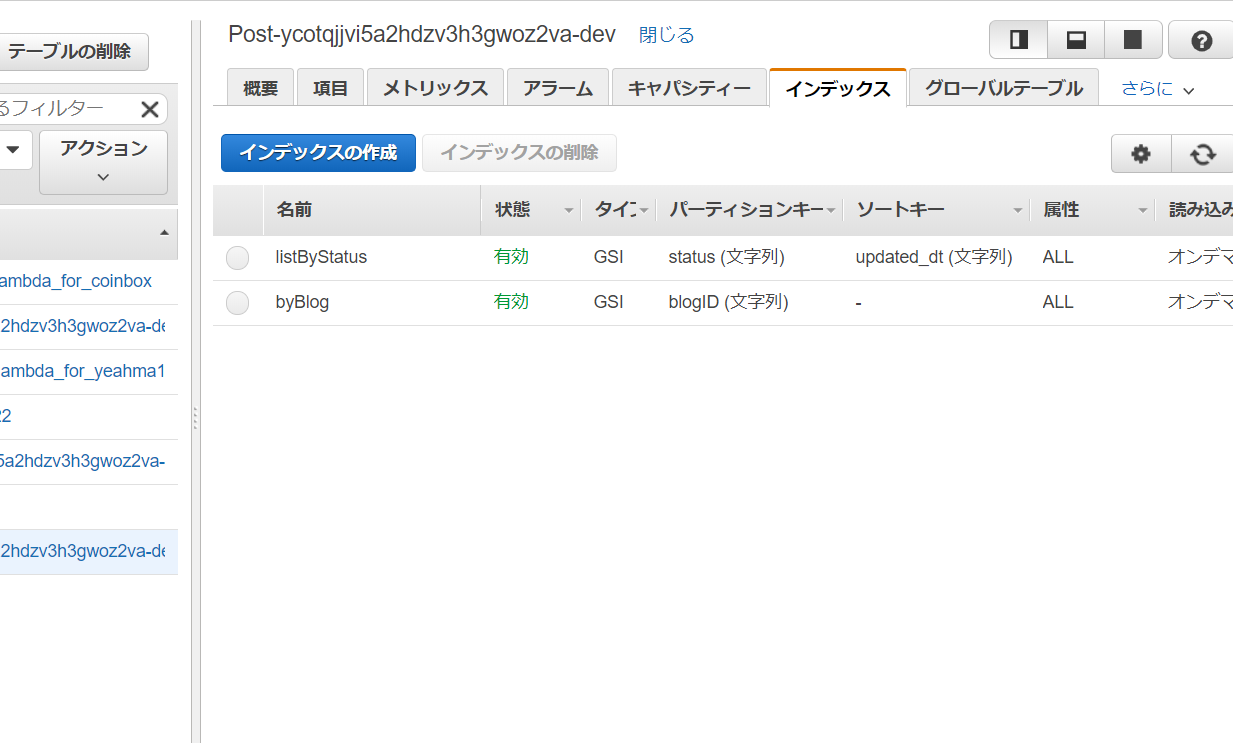だいたいこのあたりのシリーズです。
Amplify + AppSync + Cognitoで読み書きの制御を試してみる
https://qiita.com/ikegam1/items/4868b8a2b473e7ec8f85
やる事
amplify側で amplify add api やら amplify pushやらするとして、DynamoDB側のGSIとか制御できるのかどうか気になったので試してみる回です。
目次
- 初期設定
- スキーマ作成
- DynamoDB確認
- 参考
1. 初期設定
今回は下記が終わっているものとします。
- amplify cilインストール (4.24.3 でした)
-
amplify add authによるcognitoの設定 -
npx create-react-app react-amplifiedreactかつ react-amplified ってプロジェクトフォルダで進める - プロジェクトフォルダ内での
amplify init - 実行環境はWSL2上のubuntu18.4です。
2. スキーマ設定
2-1.
amplifyで生成されるBlog exampleをモチーフにしつつ下記のようなスキーマを作成してみます。
type Blog @model
@key (fields: ["id"])
@auth(rules: [
{ allow: owner },
{ allow: private, operations: [read] }
])
{
id: ID!
title: String!
owner: String!
updated_dt: AWSDateTime!
created_dt: AWSDateTime!
TTL: AWSTimestamp!
posts: [Post] @connection(keyName: "byBlog", fields: ["id"])
}
type Post @model
@auth(rules: [
{ allow: owner },
{ allow: private, operations: [read] }
])
@key (fields: ["id"])
@key (
name: "listByStatus",
fields: ["status", "updated_dt"],
queryField: "listPostsByStatus"
)
@key(name: "byBlog", fields: ["blogID"]) {
id: ID!
title: String!
blogID: ID!
status: String!
owner: String!
updated_dt: AWSDateTime!
created_dt: AWSDateTime!
TTL: AWSTimestamp!
blog: Blog @connection(fields: ["blogID"])
}
type Memo @model
@auth(rules: [
{ allow: owner }
])
@key (fields: ["owner", "updated_dt"]) {
id: ID!
memo: AWSJSON!
owner: String!
updated_dt: AWSDateTime!
created_dt: AWSDateTime!
TTL: AWSTimestamp!
}
-
@authを指定してみた -
@keyでPKやSKを指定してみた -
@keyでGSIを指定してみた - AWSDateTimeやAWSJSONというAppSyncで使える型を使ってみた
2-2.
次に amplify add apiします
$ amplify add api
? Please select from one of the below mentioned services: GraphQL
? Provide API name: reactamplified
? Choose the default authorization type for the API Amazon Cognito User Pool
Use a Cognito user pool configured as a part of this project.
? Do you want to configure advanced settings for the GraphQL API No, I am done.
? Do you have an annotated GraphQL schema? No
? Do you want a guided schema creation? Yes
? What best describes your project: One-to-many relationship (e.g., “Blogs” with “Posts” and “Comments”)
? Do you want to edit the schema now? Yes
GraphQL schema compiled successfully.
Do you want to edit the schema now? のとこで前述のスキーマを記述します。
そして
amplify push
(そういや、? Choose the code generation language target のとこで出てくるflowって何だろね?気が向いたら調べる)
pushが完了したら、作成されたリソースを確認してみましょう。
まずはAppSyncのコンソールを
3. AppSync コンソール
ちゃんとスキーマが反映されてる。なるほど、BlogとPostのリレーショナルはこんな感じになるのか。
で、こんな感じでMutation実行しときます。
AppSyncコンソールのクエリのとこから実行できます。
mutation MyMutation {
createBlog(input: {title: "日記ブログログ", updated_dt: "2020-08-10T11:11:11.111Z", created_dt: "2020-08-10T11:11:11.111Z", TTL: 1572268323, owner: "testUser01"}) {
id
}
}
mutation MyMutation {
createPost(input: {title: "今日のカレー", blogID: "7998ea07-d679-4a6d-bca8-5ce6af692929", status: "ACTIVE", owner: "testUser01", created_dt: "2020-08-10T11:11:11.111Z", TTL: 1572268323, updated_dt: "2020-08-10T11:11:11.111Z"}) {
id
}
}
mutation MyMutation {
createMemo(input: {memo: "{}", owner: "testUser01", updated_dt: "2020-08-10T11:11:11.111Z", created_dt: "2020-08-10T11:11:11.111Z", TTL: 1572268323}) {
id
}
}
owner は明示的に記載しない方がいいのかな。cognito上のユーザー名を入力してみたけどあってるかわからん。
あとcreatedAt とかupdatedAt も作られてる。これも明示的には作らない方が良さそうだ。
なお、Queryはこんな感じ。
query MyQuery {
listPostsByStatus(filter: {owner: {beginsWith: "Test"}}, status: "ACTIVE", updated_dt: {ge: "2020-08-01"}) {
nextToken
items {
owner
status
title
id
created_dt
}
}
}
filterを設定しないとなんか怒られた。
- DynamoDB側
次にDynamoDBの定義がどんな感じになってるか確認。
ちなみにAppSyncのデータソースのところはこういう感じ。
Postsの項目
__typename っていうのが作られてる。
creaetdAt とかにはnowな時間が勝手に入ってくれるんですね。
PostsのGSI
うん。想定通り。 @key で指定すれば作られる。
あんまり複雑な事をしないのであればけっこう簡単そうな印象。
5. 参考
https://docs.aws.amazon.com/ja_jp/appsync/latest/devguide/scalars.html
https://d1.awsstatic.com/ja_JP/startupday/sudo2020/SUD_Online_2020_Tech07.pdf
これも忘れずに
$ amplify delete
